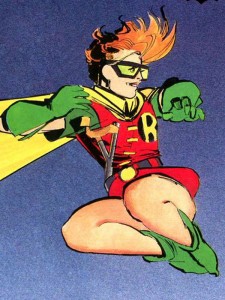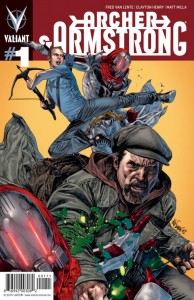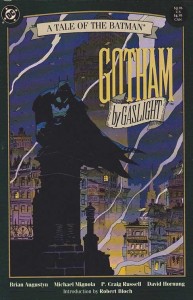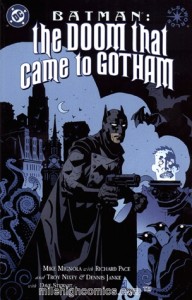Morrison’s Batman lives. It runs, it hurts, it gets sick, it heals. You can see the birth there, in those bits of 52. You can find it learning how to breath, death becoming a second motion – little deaths becoming a pattern of the world they live in. Batman is dying again and again, little deaths until the end with the 13th issue of Inc. But Batman never dies. Batman and Robin never die. We’ve been graced with an unkillable mortal and he has graced up with his son and so we look at the future before us.
Tag: batman
My Own Brand of Justice League – Apokolips Now – Ziah Grace
After Morrison’s ground-breaking run (and subsequent follow-up by Mark Waid) wherein he turned the Justice League of America into the “Big 7” of the DC universe, it’s been a bit hard in follow-up iterations for me to picture anyone else on the team. Still, just because there’s a “Big 7” that takes care of the huge stuff doesn’t mean there’s not a place for other heroes. What happens when something comes up that requires a quiet, stealthy reconnaissance? Wonder Woman, Aquaman, Superman, and Green Lantern aren’t exactly known for their sneakiness.
So, here’s my pitch. Batman starts hearing some rumblings that something might be going on over in Apokolips, specifically where Darkseid might be concerned. Batman thinks he’s planning something, but he needs more info, so he assembles a stealth team to infiltrate Apokolips, find out what Darkseid’s planning, stop it if possible, report back if not. Unfortunately, Amanda Waller’s heard the same rumors, and thinks that Batman’s team will blow the mission if left unattended, so she forces her operatives (Bronze Tiger and Nightshade) onto the team to make sure it’s a success. Leading the team are:
Big Barda and Mr. Miracle

As Apokolips natives, they’ll function as guides and informants, filling in the team on what they need to know as they try to figure out what the team is planning. Mr. Miracle is the tech expert, and Barda plans the assaults (even when there aren’t any).
Dick Grayson (Batman)
Batman sends Dick in to be his eyes on the ground, and, since he knows just about everyone in the DCU, to smooth things over between the team members. He’s Batman because Dick Batman was great.
Bronze Tiger
A long-time member of the Suicide Squad, and the one of the few people in the DCU that’s a better fighter than Batman, Bronze Tiger was Waller’s first choice to find out what Darkseid is planning. He might be the best fighter on Earth, but what about Apokolips?
The Atom (Ryan Choi)
A scientist first, and a superhero second, he’s on the team because Batman needs as many thinkers on the team as he can get, especially if Barda’s calling the shots. As the Atom, Ryan Choi’s had some experience with crazy alien technology, but he’s going to find that Apokolips is a bit worse than cabbies that speak in anagrams and Cancer Gods. Still, he’ll get some help from Mr. Miracle, who respects his ingenuity and quick thinking.
Nightshade
The second of Waller’s agents, she serves as both the group’s transport with her teleportation, and keeping them hidden with her control over the shadows. She and Bronze Tiger have been to Apokolips before, but it’s changed, and they doesn’t have the rest of the Suicide Squad backing them up this time.
Vixen
As one of the most adaptable superheroes in the DCU, Vixen’s a good choice to round out the team. Strong, quick, and trustworthy, Vixen thinks she’s ready for anything. Anything, that is, except old flame Bronze Tiger being on the mission, and an entirely new Red for her to connect to on Apokolips…
Robin (Carrie Kelly)
In some sort of mad science craziness, a bunch of Apokolips technology goes wild, pulling in Carrie Kelly from the Multiverse right as the Stealth Team arrives. Seizing onto the familiar figure of a Batman costume, she ends up being dragged along by the team as they try to complete the mission anyway. She’s got a lot of questions, and Dick might not have all the answers she wants to hear in this new universe.
Jimmy Olsen
Jimmy was looking for a story on Apokolips to fill out the Sunday morning edition when all of a sudden he saw half a dozen superheroes leap out of the shadows and start dashing off. Thinking he’s found a better story, he ends up following them, much to Bronze Tiger’s intense annoyance. Luckily for the team, Jimmy can hold his own; he brought some self-defense tools with him: some Elastic-Lad serum, his genie pal Korul, and his own mastery of the martial arts.
Throughout their infiltration, they’ll come up against Granny Goodness, the Female Furies, and even get a bit of help from the Green Lantern of Apokolips, Rakar Qarrigat.
Graceland Reviews, London Edition-
I have been in London, so here are some comics I picked up there. Feel free to tell me why I’m stupid for liking something or for disliking AvX (You’d be wrong, but you’re welcome to your opinion)
Harbinger #3, Joshua Dysart, Khari Evans:
“We’re an army in training for a corporation?”
I’ve been dubious on whether or not this comic could make a turnaround from an event in the first two issues when the protagonist uses his mental powers to force a girl to fall in love with him and then has sex with her, a plot point that made the book hard to read, and harder to recommend. Still, I figured I’d give Joshua Dysart a few issues to show his hand, seeing as his run on the Unknown Soldier was one of my favorite comic runs, and I’m glad that I did. Instead of using the really gross action as a quick way to motivate Peter to advance the plot, it’s becoming clear that Dysart is actually making an extraordinarily broken “hero”, of whom nearly every other character in the book looks at with disdain or fear, an opinion echoed by the reader. At this point in time, Peter should be a disgusting individual, and even when we get some back-story to elicit sympathy, it’s immediately halted by Peter being a dick to people. I’m fascinated to see where this can lead, and whether Dysart will actually give him a positive character arc or failed redemption. Past the story part of it, the art by Khari Evans isn’t quite to my liking; he or she does a fair job at concise storytelling, but the art just isn’t quite at a level as to be a draw on its own.
SPACE JAM OF THE WEEK
Archer and Armstrong #1 Fred Van Lente, Clayton Henry:
“Noooooo—I wanna ride dinosaurs like they did in Caveman times”
This right here is my jam. Fred Van Lente and Clayton Henry (of the Incredible Hercules, one of the best comedic action comics ever) reuniting for a story about an immortal, who might as well be “The Dude” from The Big Lebowski and the naïve assassin that’s been charged to kill him, teaming up and fighting people for alien technology. First issues are always tough to pull off, but Van Lente and Henry do a great job, setting up the story, introducing the characters, and having more than a few fun action set-pieces. I’m looking forward to seeing more of this comic when they fall into groove. Unfortunately, I can’t help but feel like the art’s a bit lacking, and I’m wondering if it’s the coloring. There’s a whole lot of grays and blacks in this comic, and Henry’s work on Incredible Hercules showed that a wider color palette looks just as professional.
Atmospherics, Warren Ellis, Ken Meyer Jr.:
“You’re a junkie that gets homicidal urges on heroin.”
So, this is basically a story that Warren Ellis wrote after he saw a documentary on cow mutilation and watched the X-Files for a while. It’s so short and one-note, it’s almost a waste to give any sort of plot summary to it. Of the other mostly half-baked Ellis Graphic Novellas, I’d say it’s not the worst, but why would you waste time reading a comic that’s really just not the worst?
Batman: International Written by Alan Grant and Mark Waid, drawn by Frank Quitely, Diego Olmos, and Arthur Ranson:
“Mr. Wayne, viewers want to know: what’s under your kilt?”
Frank Quitely has a two-parter in here about Batman in Scotland, written by Alan Grant, and it’s really interesting to see Quitely’s work when he’s not written by Morrison. I’m so used to their collaborations at this point that I found myself checking backgrounds and tiny details out of the habit that they would play into the story later, despite this being just a rather straightforward “Batman solves crime in a new place” story. Once I stopped that, I realized something about Quitely that I somehow hadn’t noticed before: He rarely uses speed lines or ghosting to communicate action; instead, he chooses the exact moment of time and body language of a character to imply the preceding and proceeding actions. And yes, I realize that’s the object of cartooning, and probably something that everyone knows about Quitely, but it was something I’d never realized since I was always distracted with trying to figure out Morrison’s writing. Anyway, the story’s fine, and it’s worth reading just to see how Quitely can elevate just about any comic script, which will probably be put to the test (hyperlink Millar’s comic). The other two stories are a neat Mark Waid story that isn’t jaw-dropping, but has a neat tweak on the character of Killer Croc, that if given the time and inclination, I think some writers could do some interesting things with, and an Alan Grant story that is a mediocre tale of Batman’s mystic training coming back to haunt him in the present day. This trade’s bargain bin at best, but if you can get a nice price, I doubt you’ll regret buying it.
SVK: I ended up writing a longer review of this one. Short version: it’s fine, not great.
“Rape-looking zombie bastard”
AvX #10 Ed Brubaker, Adam Kubert
“Is that a dragon?”
Why is this comic still going? UGGGGGHHHH, I hate it, I hate it so much. Every character is stupid and poorly written, and it’s not even about Avengers fighting X-Men anymore. It is seriously about Avengers (which includes pretty much all the X-Men at this point) fighting two crazy mutants with god-like power, one of whom is killing people and making others bow to her. How is this even a good plot twist? How is this worth the paper that it’s printed on? How will it end? Answers in order: It’s not, it’s not, and I don’t give a shit.
Lego Batman 2 Review
Developed by Traveller’s Tales
Published by Warner Bros.
Lego Batman 2 marks a few firsts in the Lego series: first to include voice acting, first to include a truly open world, and first to include splitscreen in any meaningful capacity beyond some vehicle levels, but these are balanced out by somewhat broken implementation and a redundant-feeling roster.
TO DC ENTERTAINMENT: A SUGGESTION FOR THE FUTURE OF BATMAN MOVIES
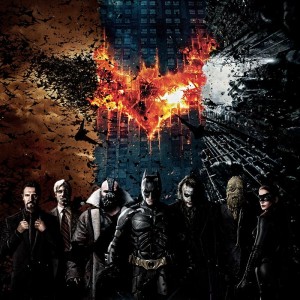
First off, congratulations for pulling off a successful, both critically and commercially, trilogy. I wholeheartedly recommend Christopher Nolan’s Batman movies to everyone. Linked together, they are a masterpiece of storytelling that not many creators could pull off.
Which brings us to the point of this article, following up that work. You must be thinking about it. Marvel is raking up profits with not only their own studio but with their licensed properties as well. THE AVENGERS is the biggest movie of the year. Third of all time. And if any DC character can match that success, it’s Batman. Everyone loves Batman. How to start over though? Another dramatic take that could very well be hurt by people’s fondness for Nolan’s? A more “superhero” take to lead to a Justice League movie? All an out homage to Batman ’66? I’m suggesting the unconventional option. An Elseworlds movie.
Red Rain. Gotham By Gaslight. In Darkest Knight. All great stories that would make incredible movies. Batman’s origin can basically happen the same way in any time period without losing an ounce of resonance. With only a few frames of screentime and the public awareness of Batman his origin can be alluded to quickly and not obtrusively. Placing Batman in a different setting gives you a way to separate the new film from the trilogy. It’d be hard for someone to think about the Nolanverse while seeing Batman facing vampires or racing though cobblestone streets in a horse-drawn carriage. And the most important factor: you can do these movies almost concurrently. Why wait three, five years between movies when you can have a whole different cast and crew working on the next while the first is still being filmed?
What my suggestion boils down to is to not let convention dictate what your next step should be. You’ll get a lot of people saying “audiences will be confused” and “everyone is expecting blah blah,” but that’s the old way. There are three viable interpretations of Sherlock Holmes active on TV and in theaters. You have a character that can function on so many levels and you control every way it could be presented. Why not exploit it?
Let Batman fly.
Mad Love: A Summary and Description of Psychological Problems
(I originally wrote this for my Abnormal Psychology class)
The following paper is a summary of the events of Mad Love, originally published as The Batman Adventures #12: Mad Love in February 1994. Mad Love was written by Paul Dini and Bruce Timm with Timm providing the primary illustrative work. It is followed by a summary and discussion of the mental issues of the primary character, Harley Quinn.
Mad Love is a story of obsession, lovesickness and ultimately unrequited love. The story tells the origin of the Joker’s partner Harleen Quinzel or Harley Quinn, who after fumbling an attempt to kill Batman, is kicked out of the group in a fit of the Joker’s rage. Instead of seeing the Joker’s lack of true affection for her and his ultimate obsession with killing his enemy, Batman, Quinn blames Batman for the misfortune tossed upon her and plots to destroy him with one of the Joker’s own plots.
The story then shifts as Batman reviews Harley’s past. She was a psychology student who was seeking fame and who was willing to use her sexuality as a tool to ultimately get whatever she wanted. Her biggest goal was to write a pop psychology book on one of the many supervillains in Arkham Asylum and she soon received internship position due to her “good grades.” In reality, Arkham Asylum really acts as a holding cell for the various supervillains of Gotham City and soon Harley is introduced and entranced by the Joker who points out how close her name is to the word “Harlequin”. After their meeting she finds a flower in her office from the Joker, Harley feels that the Joker feels the same feelings for her.
Harley then begins an obsessive quest over the next three months to gain some time for one on one time with the Joker as a patient and due to her dedication; she achieves that privilege despite warnings about the Joker from the rest of the staff. In their first meeting the Joker tells Harley how his father beat him as a child. Feeling sympathetic and thinking that she was breaking through to what makes the Joker tick, she organizes more psychological meetings with the Joker slowly becoming the one analyzing her.
After the Joker breaks out of and is then subsequently returned to prison, Harley, who was suffering without the Joker, decides to break the Joker out of prison for good. By robbing a costume store and taking on the person of Harley Quinn she soon returns to the asylum and the pair bust out of the prison. Harley is mentally hoping to marry the Joker after they kill Batman and then start a family meanwhile the Joker is happy to be out of prison again. The two soon begin a life of crime and incarceration that leads back to the current story.
Quinn ends up sending a video to the Gotham Police under the premise that she worries the Joker is going to go too far and she promises to give herself up to the police if Batman will protect her only for the result to turn into a trap. Batman wakes to find himself in a trap he can’t escape from. The premise of the trap – The Death of 1000 Smiles, is that Batman will be lowered upside down into a tank of piranhas where he will be eaten alive. The reason for being hung upside is so that the piranhas will seem to smile since they normally seem to frown.
Batman convinces Harley that the Joker will only believe that she killed Batman if he is there during his demise. Batman then asks what stories the Joker told Harley to gain her trust explaining that the Joker has lied to other people about his abusive past, which Harley refuses to believe. Harley calls the Joker, who is missing her because she kept the place tidy and clean, only to be horrified that she has captured his enemy fearing emasculation if his hench-woman were to kill his nemesis.
Upon reaching the hideout where Harley has Batman, the Joker grows furious as Harley has to explain the joke of her plan and he ends up tossing her out the window where the police find her. Meanwhile the Joker releases Batman from the chains and to him. Batman then reveals that he expected the Joker to not allow anyone else to kill and that was the only way he could escape. Batman then defeats the Joker who disappears before his capture. Meanwhile Harley, after being released from the hospital, decides to give up on the Joker on to return to Arkham to find a flower for her from the Joker and she sees this as a sign that the Joker still loves her.
Ultimately diagnosing Harley is a difficult thing to do because officially romantic obsession or lovesickness is not diagnosed in the DSM. I will note though, that there has been increasing demand though in the psychological community to allow more types of obsession to be allowed into the DSM and there are additionally types of romance afflictions that were previously diagnosed by psychologists due to their being physical and psychological affects. Additionally in the Batman canon Quinn is able to reach some levels of self sufficiency wherein she becomes a fully developed character and villain in her own right, though she does hold a tendency to ally herself with others as opposed to working alone or with just henchmen. For the sake of the paper though I will disregard this information and diagnose simply on mental disorders.
The first step of diagnosing the condition is discerning the symptoms of the character in question. Harley for one dresses in her harlequin costume at all times and even fantasizes about continuing to wear it in old age as it draws attention to her and is part of her. She is frequently consumed with sexual feelings towards the character of the Joker despite there being no fully established cause for romance on his part besides seeing her as a tool to be used. She additionally shows no emotional reservations about hurting other people and can even treat this threatening of other people as a game to play, thus explaining her childlike demeanor towards violence as that attracts attention. She is also frequently laughing while causing violence, which is an example of her being unable to appropriately react to the situation showing a general inability to follow societal norms. Due to the symptoms I would diagnose her with disingenuous histrionic personality disorder.
Disingenuous histrionic personality disorder is a subtype of the histrionic personality disorder diagnosed by Theodore Millon that is essentially histrionic personality disorder combined with antisocial symptoms, both of which are seen in the character of Harley Quinn. Symptoms of histrionic personality disorder according to the DSM-IV-TR 301.50 are as follows.
A pervasive pattern of excessive emotionality and attention seeking, beginning by early adulthood and present in a variety of contexts, as indicated by five (or more) of the following:
• is uncomfortable in situations in which he or she is not the center of attention
• interaction with others is often characterized by inappropriate sexually seductive or provocative behavior
• displays rapidly shifting and shallow expression of emotions
• consistently uses physical appearance to draw attention to self
• has a style of speech that is excessively impressionistic and lacking in detail
• shows self-dramatization, theatricality, and exaggerated expression of emotion
• is suggestible, i.e., easily influenced by others or circumstances
8. considers relationships to be more intimate than they actually are.
Meanwhile antisocial personality disorder symptoms according to the DSM-IV-TR 301.60 are as follows:
A. There is a pervasive pattern of disregard for and violation of the rights of others occurring since age 15 years, as indicated by three (or more) of the following:
1. failure to conform to social norms with respect to lawful behaviors as indicated by repeatedly performing acts that are grounds for arrest
2. deceitfulness, as indicated by repeated lying, use of aliases, or conning others for personal profit or pleasure
3. impulsivity or failure to plan ahead
4. irritability and aggressiveness, as indicated by repeated physical fights or assaults
5. reckless disregard for safety of self or others
6. consistent irresponsibility, as indicated by repeated failure to sustain consistent work behavior or honor financial obligations
7. lack of remorse, as indicated by being indifferent to or rationalizing having hurt, mistreated, or stolen from another
B. The individual is at least age 18 years.
C. There is evidence of conduct disorder with onset before age 15 years.
D. The occurrence of antisocial behavior is not exclusively during the course of schizophrenia or a manic episode.
As examples of her symptoms as being histrionic, Harley is seen as being clingy after a bad event attempting to get the Joker’s attention from focusing revenge on Batman. After the failed heist she also attempts to use sex for attention (and priorly used it in her life as a college student). She also talks loudly and in a way that someone as well educated would not using onomatopoeias in her speech. Additionally dresses as a clown for theatricality, she is easily influenced by the Joker and she considers her relationship with the Joker as being more intimate and real than it is. These are more than enough symptoms for her to be counted as being histrionic.
Meanwhile for her antisocial tendencies Harley doesn’t follow the law just by being a criminal and killer. Even before she was officially a criminal when she used sex to improve her grades. Also her entire persona is faked for the purposes of improving her standing in the world because she simply wants to be with the Joker so she invented the Harley Quinn person. To a lesser extent didn’t fully plot out the piranha plan or actually plan it out that well. She was just lucky enough that Batman fell into her trap. She was also unable to foresee the Joker’s reaction to her plan or Batman using her. Harley is very aggressive and reckless by the pure fact that she willingly spends time with a murderer. She also ultimately blames Batman and the police system for her failings showing an inability to blame herself for her actions and she has no problem or morality issues with being a criminal.
Ultimately these problems define her personality, her reasons for her relationship and ultimately her downfall, i.e. being captured again. As such, Quinn’s obsession with the Joker simply exacerbates her problems which due once more to the obsession, will be less likely to be curable.
Bibliography:
Boree, C. G. “Personality Disorders.” My Webspace Files. 2007. Web. 29 Aug. 2011.
Dini, Paul, and Bruce Timm. “Mad Love.” Batman: Mad Love And Other Stories. 1st ed. New York: DC Comics, 2009. 1-38. Print.
Millon, Theodore. “Personality Subtypes Summary.” The Official Website for Theodore Millon, Ph.D., D.Sc. DICANDRIEN, Inc, 2006. Web. 29 Aug. 2011.
Bear Grylls, Batman Team-Up For “BATMAN VS. WILD”
Coming soon to Discovery Channel is a new reality series showcasing how to survive
in wild, urban areas. Bear Grylls of Man Vs. Wild and Worst Case Scenario will host
the program but will be the student this time as he is trained in urban vigilantism by
the “Dark Knight” of Gotham City, The Batman.
“It’s a great opportunity to showcase the abilities of The Batman and provide just a little
transparency to this new initiative,” remarked Wayne Enterprises and Batman, Inc. CEO
Bruce Wayne. “While not a complete look into how the Caped Crusader operates, I think
the people will be both educated and entertained with the new series.”
Bear, who films specials where he takes celebrities on expeditions, will be learning
how to track a suspect, evade street cameras and tackle multiple armed assailants with
non-lethal weaponry. “We’ve deputized Mr. Grylls for the duration of taping. He’s also
provided an insurance and incidental death waiver,” Commissioner James T. Gordon
said when called for comment. While the Gotham City police department has no official
stance on the authority of Batman, they wish to provide positive exposure of Gotham
City and its residents.
Batman would not respond to any requests for a comment through Batman Inc. or the
GCPD, but his current sidekick Robin left a note with one of the cameramen for the
series.
“This is stupid. -R”





